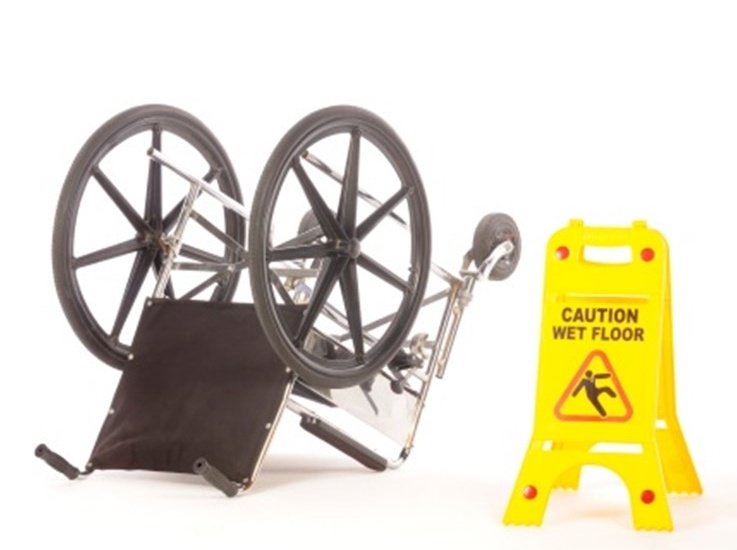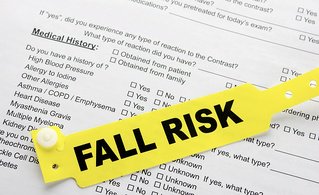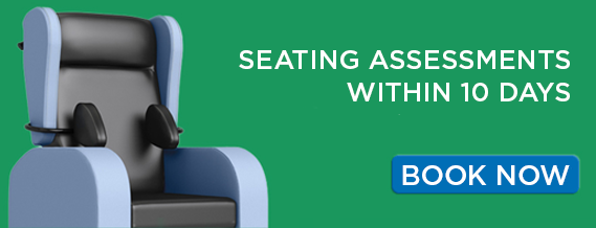Falls are a common occurrence in care facilities and hospitals and cause unnecessary suffering and pain. Fortunately there are methods to reduce falls risk – this article shares evidence based tips to support you*.
Accidental falls from chairs and wheelchairs places huge strain on the patient, their family and on healthcare budgets in dealing with and treating these preventable injuries.

High Risk Categories
Falls and fall related injuries most commonly concern elderly members of the population but also patients suffering from low mobility due to different types of muscular and neurological diseases which impair their strength, balance and sense of space. Falls can also happen as a result of medication which patients might need which can sometimes result in feeling dizzy and off balance.
Those patients who may have low strength, be unsteady on their feet or require extra assistance during sit to stand transfers are more at risk. Patients suffering from conditions such as Huntington’s Disease or Alzheimer’s Disease, with poor memory and cognitive impairment might impulsively try to stand up when seated and therefore are a high risk category. The correct seating solution can keep these patients safer, more secure and less at risk, and will reduce falls risk.
CLICK HERE TO BOOK A FREE SEATING ASSESSMENT WITH THE SEATING SPECIALIST IN YOUR AREA
When a patient has an unnecessary fall from their chair there are a large number of consequences that can result from this physically, mentally and economically.
1. Injury/Hurt – i.e. broken bones, bruising, open wounds.
2. Pressure ulcers – Repeated sliding out of a chair can cause shear which can contribute to an incidence of pressure ulcers.
3. Delayed rehab – Injuries from falls can affect rehabilitation of the patient –slowing down progress and increases time spent in hospital and usually spent on bed rest.
4. Confidence/Dignity – When a patient suffers a fall, this can really damage their confidence in themselves and they will be less likely to move around as much, and therefore may become even more immobile and dependent on others for assistance and help. This affects their dignity and pride and results in them being less independent.
5. Manual handling risks – The need for constant repositioning due to a patient sliding down their chair means an increase in staff time and an increase risk of injury due to excess manual handling requirements.
6. Expenses incurred –Care homes/hospital have additional costs to fulfill, performing operations, purchasing new equipment not to mention increased staff time to aid manual repositioning and treating injuries.
A common reason why patients end up sliding out of, or falling out of chairs is down to a lack of or an inadequate seating assessment. This results in a patient being put in a chair which typically doesn’t accommodate the four following factors:
1. Loading the body.
2. Accommodating hamstrings.
3. Accommodating hip flexion.
4. Loading of the feet on an appropriate footplate.2
A proper seating assessment with prescription of a chair tailored to a patients height, leg length and clinical needs whilst also supporting posture and function, can drastically reduce risk of falls and sliding. The following functions are key considerations:
1. Back angle recline: This function enables the back angle of the chair to be opened out to accommodate a fixed hip angle and prevents the patient being pulled forward in their seat.
2. Negative angle leg rest: This function accommodates those with tight hamstrings and enables them to be fully loaded into the chair and fully supported with their feet able to sit firmly behind the knee.
3. Adjustable footplate: This is necessary in order to load the feet as 19% of a person’s body weight goes through the feet when seated.3
4. Adjustable seat angle recline: Enables lowering the pelvis into the chair and creates a stable base of support for the person when seated.
5. The support from additional adaptations:
– Lateral supports : Help keep the posture in mid line position, reducing falling to one side and needing repositioning.
– Seatbelts: Can be useful to a certain extent but we recommend that they are only used during transfers and not constantly in use with patients.
6. Seat depth: The ability to adjust seat depth in a chair is a great function for a multi-user environment allowing one chair to suit many different body shapes. For patients with long legs, the ability to adjust the seat depth is essential to properly load the femurs into the chair.
7. Anterior leg rest function/Riser Function: Can help an individual slowly come to a standing position whilst being fully supported.
Conclusion
A thorough seating assessment and an investment in the correct, supportive equipment, can drastically improve the quality of life for patients at risk of falls and sliding from chairs. Not only that, but the additional benefits to the caregiver and the cost savings from reduced need for additional treatment and time saved repositioning cannot be underestimated. Perhaps the most important takeaway, is the reassurance to family members and caregivers that their patient or loved one is safe and secure from risk of injuries due to preventable falls.
CLICK HERE TO BOOK A FREE SEATING ASSESSMENT WITH THE SEATING SPECIALIST IN YOUR AREA
References:
1. Hospital News, Dec. 29, 2015, Don’t Hurt Me Heal Me. Be Nice to Me. https://issuu.com/hospitalnews/docs/flip_010216_hospital_news_edit_full/4
2. Tierney, M., 2015, The Clinician’s Seating Handbook, 5th Ed., Northern Ireland: Seating Matters.
3. Staas, W.E., Cioschi, H.M., 1991. Pressure sores: a multifaceted approach to prevention and treatment. Western Journal of Medicine, 154: 539-544.
*Note – the purpose of this blog is to give an overview of the product with some tips to consider on its use. This is not intended to be a substitute for professional or medical advice, diagnosis, prescription or treatment and does not constitute medical or other professional advice. For advice with your personal health or that of someone in your care, consult your doctor or appropriate medical professional.
** This post was originally published on http://blog.seatingmatters.com/reducing-the-risk-of-falls-and-sliding-from-chairs



